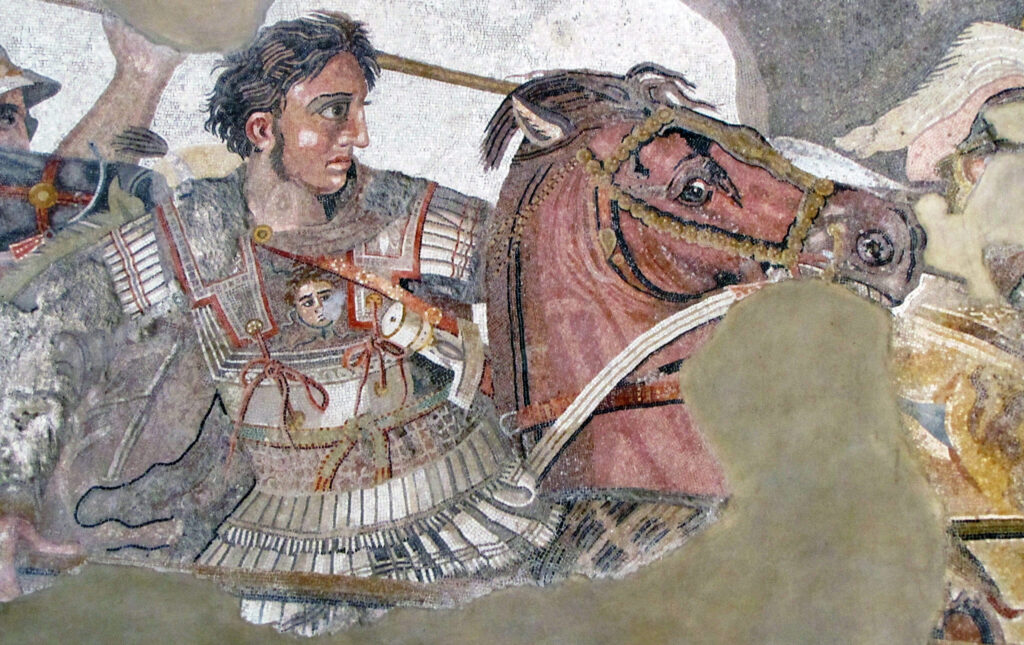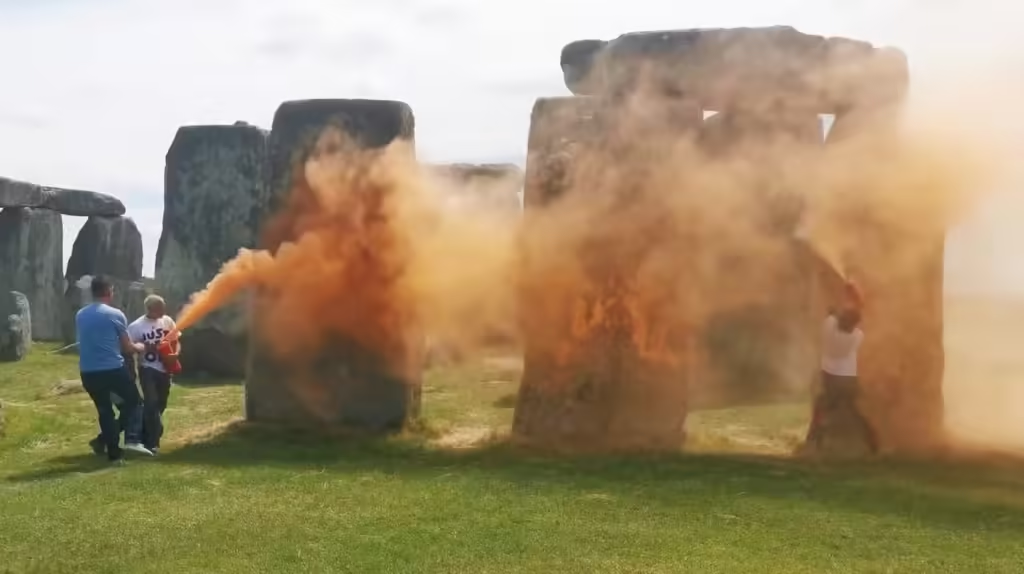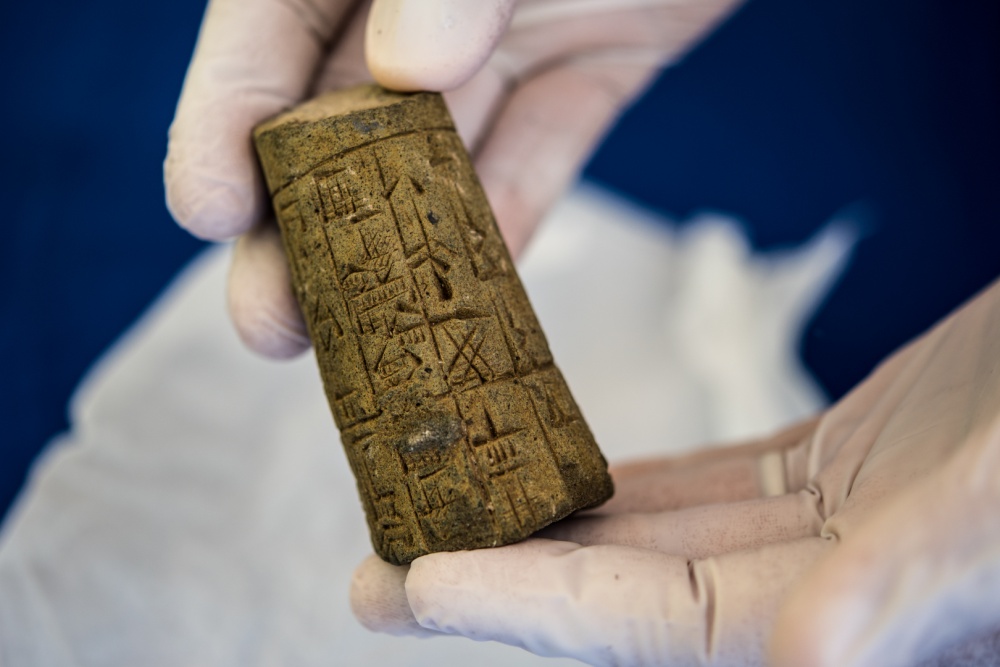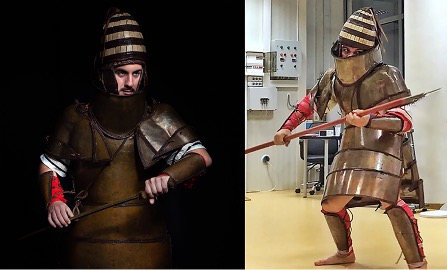Views: 46
Editors Note: Viewers are encouraged to send in your opinions on any of the news stories posted on this page. Just send your contributions to: rob@ancientromerefocused.org. Emails will be posted on line.
ZME SCIENCE
Researchers Find Hidden Clues in The Alexander Mosaic. Its 2 Million Tiny Stones Came From All Over the Ancient World
When Mount Vesuvius buried Pompeii under a torrent of ash in A.D. 79, it also preserved one of the ancient world’s most remarkable artifacts: a massive mosaic depicting Alexander the Great’s triumph over the Persian king Darius III at the epic Battle of Issus. For nearly two centuries, this intricate artwork of over 1.9 million tesserae (the tiny stones that form the mosaic), unearthed in 1831 at the House of the Faun, has captivated historians and archaeologists alike.
But a recent study has uncovered a new dimension to its story — its tesserae come from an extraordinary range of quarries spanning Europe and North Africa.

Third Person Charged Over Stonehenge Vandalism Incident
November 18, 2024 –
A third individual has been charged in connection with an incident at Stonehenge on June 19, during which an orange substance was thrown at the ancient stones.
Luke Watson, 35, from Manuden, Bishop’s Stortford, has been charged with:
- Aiding, abetting, counselling, and/or procuring the destruction or damage of an ancient protected monument.
- Aiding, abetting, counselling, and/or procuring causing a public nuisance.
Watson is scheduled to appear at Salisbury Magistrates’ Court on December 13 for a first hearing.
The Telegraph
Homer's IIiad and Odyssey hit with triggers warnings by university for distressing content
Sunday, December 29, 2024 —
Homer’s epic poems The Iliad and The Odyssey have been hit with trigger warnings by a university for “distressing” content.
The University of Exeter has come under fire after telling undergraduates they may “encounter views and content that they may find uncomfortable” in their Greek mythology studies.
In what has been branded as a “parody” and “bonkers”, students enroled on the Women in Homer module are told material could be “challenging”.
With references to sexual violence, rape and infant mortality, undergraduates are also advised they should “feel free to deal with it in ways that help (eg to leave the classroom, contact Wellbeing, and of course talk to the lecturer)” if content is “causing distress”.
However, the advice, which was obtained by the Mail on Sunday via Freedom of Information laws, has been ridiculed by both classics-loving Boris Johnson and experts alike.
The Iliad depicts the final weeks of the ten-year siege of the city of Troy by Greek city-states, while The Odyssey describes Odysseus’s successful journey back to Ithaca, set over multiple locations, timelines and alternative homelands.
Editor’s Note: This happened in the U.S. as well. It seems students are so coddled they can’t have bear to think the world is a disturbing place. I think there’s a bit of presentism in this reaction as well.
Presentism is an uncritical adherence to present-day attitudes, especially the tendency to interpret past events in terms of modern values and concepts.
This freaks me out so much, I actually wrote and produced an audio narrative on this subject. It’s called ‘MADNESS’.

A midwestern professor of classics refused to recognize the need for ‘trigger warnings’ for his students when lecturing on Roman and Greek mythology. Taking a leave of absence, he escapes to Athens, Greece and finds peace with those that share his madness.
Popular Mechanics
Archaeologists Stumble Upon a Message in a Bottle - from 200 Years Ago
- Archaeologists digging through a French cliffside located a 200-year-old message in a bottle.
- Amidst much speculation, the team opened it to find a message from another archaeologist digging at the site—200 years ago.
- The archaeologist was the first to explore the ancient location, and was notable in the area for his work.
The idea of a message in a bottle that you might toss out to sea or bury in the earth is an inherently romantic one—a bid for connection with a far-off friend, whether that “far-off” be physical or temporal. A group of students recently experienced the latter, and connected with a 200-year-old predecessor via a recent discovery in France.
The message and its vessel were discovered atop cliffs at an old Gaulish village near the port of Dieppe as a team of students—volunteering in an emergency effort as erosion chips away at the site’s history—discovered a small glass flask inside an earthenware pot.
Inside the glass bottle was a note.
artnet
Ancient Scrolls Reveal Plato's Final Resting Place
By Richard Whiddington, May 8, 2024 — Previously, it was only known that Plato was laid to rest inside the Academy, the school he founded outside Athens’s city walls around 387 B.C.E. Now, academics have discovered that he was buried not in an area used as a necropolis, but rather in a garden near the Mouseion, a worship space sacred to the Muses.
The new information has been drawn from the oldest known history of Greek philosophy, Philodemus’s Review of the Philosophers—specifically the Epicurean philosopher’s detailing of Plato’s Academy and its development under his successors. The work builds off research in 2019 when the scroll was first analyzed using shortwave-infrared hyperspectral imaging.
The text is a tiny portion of the extensive library found at Herculaneum in the so-called Villa of the Papyri. Following the eruption of Mount Vesuvius in 79 C.E., the Villa and its contents were destroyed. The papyri, however, were carbonized and remain a tantalizing, though extremely delicate, body of ancient texts for scholars.
In fact, the sheer number of Epicurean texts among the Papyri, including duplicates, has led some to suggest portions of the library belonged to Philodemus.
Just in!
ARCHAEOLOGY NEWS
Bronze Ship's Ram Recovered near Sicily.
ROME, ITALY August 26, 2024—Reuters reports that a bronze ram has been recovered from some 260 feet of water off the coast of western Sicily, near the Aegates Islands, by divers from the Society for the Documentation of Underwater Sites. The front of the ram is decorated with a helmet topped with three feathers, …Check link:
Colorado Arts and Sciences Magazine
Uncovered Euripides Fragments are 'kind of a big Deal'
CU Boulder Classics scholars identify previously unknown fragments of two lost tragedies by Greek tragedian Euripides
After months of intense scrutiny, two University of Colorado Boulder scholars have deciphered and interpreted what they believe to be the most significant new fragments of works by classical Greek tragedian Euripides in more than half a century.
In November 2022, Basem Gehad, an archaeologist with the Egyptian Ministry of Tourism and Antiquities, sent a papyrus unearthed at the ancient site of Philadelphia in Egypt to Yvona Trnka-Amrhein, assistant professor of classics. The two scholars have also recently discovered the upper half of a colossal statue of the ancient Egyptian Pharaoh Ramesses II in their joint excavation project at Hermopolis Magna.
She began to pore over the high-resolution photo of the papyrus (Egyptian law prohibits physically removing any artifact from the country), scrutinizing its 98 lines.
CU Boulder classicists Yvona Trnka-Amrhein (left) and John Gilbert (right) spent months studying a small square of papyrus and became confident it contains previously unknown material from two fragmentary Euripides plays, Polyidus and Ino.
“It was very clearly tragedy,” she says.
Check link below:
Smithsonian Magazine
Archaeologists Unearth Four 1,900-Year-Old Roman Swords in Israeli Cave
Archaeologists in Israel have discovered four Roman-era swords in a cave near the Dead Sea. Even at roughly 1,900 years old, the artifacts are “exceptionally well preserved,” according to a statement from the Israel Antiquities Authority (IAA), which announced the find earlier this week.
British Museum Website
The Position of the Trustees of the British Museum
The British Museum tells the story of cultural achievement throughout the world, from the dawn of human history over two million years ago, until the present day. The Parthenon sculptures are a significant part of that story.
The Museum is a unique resource for the world: the breadth and depth of its collection allow a global public to examine cultural identities and explore the complex network of interconnected human cultures. The Trustees lend extensively all over the world and over 4.5 million objects from the collection are available to study online. The Parthenon sculptures are a vital element in this interconnected world collection. They’re a part of the world’s shared heritage and transcend political boundaries.
The Acropolis Museum allows the Parthenon sculptures that are in Athens (about half of what survives from the ancient world) to be appreciated against the backdrop of Athenian history. The Parthenon sculptures in London are an important representation of ancient Athenian civilisation in the context of world history. Each year millions of visitors, free of charge, admire the artistry of the sculptures and gain insight into how ancient Greece influenced – and was influenced by – the other civilisations that it encountered. The Trustees firmly believe that there’s a positive advantage and public benefit in having the sculptures divided between two great museums, each telling a complementary but different story.
Letter in the Financial Times 10 January, 2024: Give Parthenon marbles a one-way ticket home
One of your predictions for 2024 (FT Report, December 30) is that Britain will return the Parthenon marbles to Greece, albeit via a loan agreement rather than a full return.
You are probably right but I don’t think it is so much a question of if, but only when the marbles will eventually return to their home country. However, the idea of a temporary loan is not the solution.
The sculptures are far too fragile to be shipped between the two countries on a frequent basis. It is a forgone conclusion that it will have to be a one-way ticket.
The Elgin marbles have been well cared for by the British Museum but circumstances have changed. It is now widely acknowledged that the new Acropolis Museum is the appropriate home for the sculptures. This is also backed by a large majority of the British population.
Put it another way. The Parthenon marbles have been on loan to Britain for more than a century and now the time has come to return them to their country of origin.
Update!
IFL Science
Archaeologists Find Shipwrecks Using Clues From Homer's Iliad
By James Felton, Senior Staff Writer
Researchers from Greece’s National Research Foundation and the Ministry of Culture used various historical sources to locate 10 shipwrecks that sunk at points between 3000 BCE to World War II around the island of Kasos. Among these sources was Homer’s Iliad, which references Kasos as a trading hub that joined the fight against Troy.
Vessels found included wrecks from 3000 BCE, the classical period (around 450 BCE), Roman times (200 BCE – 300 CE), through the medieval and Ottoman periods, as well as one 25-30 meter (82-98 feet) wooden boat with metal components believed to be from around World War II, according to a statement from the Greek Ministry of Culture.
https://www.iflscience.com/archaeologists-find-shipwrecks-using-clues-from-homers-iliad-73448
GRAM O PHONE
Euronews
SUN NEWS AUSTIN
ARTnews
Literary Hub

Editor’s note: Fools and idiots!
BBC
Part of Stonehenge has been covered in orange powder paint by protesters. Two Just Stop Oil campaigners sprayed the powder paint on the historic site near Salisbury, Wiltshire, at about 12:00 BST on Wednesday. The move comes the day before celebrations begin for the Summer Solstice at the 5,000-year-old landmark. Wiltshire Police confirmed two people had been arrested on suspicion of damaging the ancient monument.
The Guardian
Return the Parthenon Marbles. The British Museum has too much stuff anyway
Simon Jenkins
Wed 29 Nov 2023
The Parthenon marbles row is beyond silly. Rishi Sunak screeches “Mine, mine” like a child in a playground. He refuses a cup of tea with the Greek prime minister, Kyriakos Mitsotakis. The leader of the opposition laughs. The nation yawns – polls show over half are happy to see the marbles returned and just above 20% want them to stay. Any civilised Briton knows they should be displayed where they belong – in their former home of Athens. But what fun it is to think up smart reasons why this should never happen.
Sunak’s quest for a daily headline gets more frantic by the day. There was something synthetic about Monday’s incident. Mitsotakis’ reference to the separated marbles being like the Mona Lisa cut in half might be over the top. But as any visitor to Greece knows, what to Britain is a boring scholastic quarrel is to Greeks a burning sense of grievance that will not go away. This is an asymmetrical row.
Of course Britain has legal title to the statues, but laws can be changed. Of course Lord Elgin probably saved them from destruction, though they were later damaged in cleaning. Of course repatriating them might be a precedent if you want to make it so, but not if you don’t. It is true that more people see the marbles in London than they would in Athens, but they do not see them complete. And so what? We are not moving the pyramids to London for a bigger show.
The marbles issue is simply about the integrity of one of Europe’s greatest artistic compositions. These statues came from the fountainhead of European culture at its most formative moment, in the 5th century BC. That fountainhead was on the Acropolis in Athens, gazing out over the sunny Aegean with marble from the adjacent mountain, not imprisoned in a cold, grey chamber in Bloomsbury.
It is true that reproduction can nowadays enable the naked eye and the human brain to appreciate the beauty of the original in a copy. Were the marbles cast from bronze, like St Mark’s horses in Venice or David in Florence, they could be copied over and again. The “cast courts” that brought European art to dozens of American museums in the 20th century were destroyed only by museum snobbery, replacing wonder with a craving for authenticity.
Science could satisfyingly replicate the Parthenon marbles in both Athens and London. But to the Greeks – far more than any Britons – this is indeed about authenticity. The Parthenon is their ancestral temple and the marbles their crown jewels. They badly want them back. And surely a cultured country such as Britain should have the dignity to oblige. It has the power to restore integrity to this stupendous composition in the land of its creation. Instead it humiliates itself by taking umbrage over a cup of tea.
Bringing empire into these arguments is rarely helpful. But a post-imperial arrogance has crept into the marbles debate. Britain’s government is telling the rest of the world: you may have got your independence back, but you are not getting your stuff. You Greeks, it seems to say, were too weak to stop the Ottomans giving away your marbles, so that is tough on you. Britain may not have its empire but it has the echo of one in the inviolability and “global context” of its British Museum. So tell the Greeks they should be proud to see their relics sit alongside the finest of Africa and Asia. They should thank British taxpayers for being able to see them for free.
The great collections of antiquity are more or less confined to a few grand museums in Europe and America, products of national aggrandisement in the 19th century. These institutions are fanatically reactionary. They want to deny newly emergent countries the scope to acquire similar collections by refusing to dispose or de-acquisition their vast reserves. Many have the vast amount of their works in store, as if they were the private property of their custodians. In the 1970s, the British Museum even declared itself primarily a research resource for scholars.
None of these millions of objects was created to be locked away in perpetuity in a London basement. Most were made in far-off countries whose citizens might be proud to display them in public. There is nothing sacred about a museum. It is an unnatural place to leave thousands of objects frozen in time and place, vulnerable to theft and decay.
Museum walls are now crumbling ideologically if not physically. France has a major programme of repatriation of imperial objects, whether looted or not. So does Germany. Despite concerns over security, African bronzes are returning to Africa, ceramics to south-east Asia, tribal treasures to Polynesia. This does not mean the death of the Louvre.
The V&A’s director, Tristram Hunt, this week floated a reform of the 1983 National Heritage Act that at present curbs certain museums from “de-acquisitioning”. He wants them to grow up and take charge of their own business. The truth is that most museums have too much stuff, far too much. They should distribute it to the rest of the world. Returning the Parthenon marbles might indeed be a precedent, and an excellent one.
Reuters
Greek PM repeats call for return of Parthenon Sculptures to Athens.
GREECE IS...in the news.
Ottoman Archives Reveal Elgin Took Marbles Illegally, Experts Claims.
Drawing on data gleaned from 19th century Ottoman archives, Acropolis Museum Director Dimitrios Pandermalis has challenged claims by the British Museum that Lord Elgin had obtained permission from the sultan when Greece was under Turkish rule to transfer the Parthenon Marbles from Athens to London.
“There was no firman – meaning a sultan’s decree – for the removal and transfer of the sculptures by Lord Elgin,” Pandermalis said in an address Monday to an international workshop titled “Reunification of the Parthenon Sculptures” – co-organized by the Greek Presidency, the Culture Ministry, the International Association for the Reunification of the Parthenon Sculptures and the Acropolis Museum.
More specifically, he said that an examination of the Ottoman archives between 1800 and 1830 by two Turkish experts revealed that Elgin was only granted permission to dig around the Acropolis.

Editor's Note: Laura Young you are awesome!
artnet
An Ancient Roman Bust Purchased for $35 at a Texas Thrift Store Is Now Being Repatriated to Germany
npr
3.800 artifacts once bought by Hobby Lobby were just returned to Iraq

Thousands of ancient clay and stone artifacts that were smuggled into the U.S. and shipped to Hobby Lobby stores will be returned to Iraq, the U.S. Immigration and Customs Enforcement announced today.
The artifacts, including cuneiform tablets, cylinder seals and clay bullae, were falsely labeled on the shipping labels as tile “samples,” ICE said in a statement last year, announcing a formal civil complaint against the arts-and-crafts retailer.
Soon after, Hobby Lobby agreed to pay a $3 million fine and surrender its cache of artifacts that the company had acquired in 2010 through dealers based in the United Arab Emirates and Israel.
At the time, Hobby Lobby president Steve Green said in a statement that the company “should have exercised more oversight and carefully questioned how the acquisitions were handled,” signaling that it was inexperience that led to the smuggling. The Justice Department, however, said the acquisitions were “fraught with red flags.”
How did a chain selling arts and crafts supplies get in trouble for smuggling artifacts? Here’s a breakdown:
What did Hobby Lobby do?
Hobby Lobby purchased more than 5,500 artifacts for $1.6 million dollars and imported these historical antiquities against federal law. According to the civil complaint, restrictions have been placed on importing Iraqi cultural property since 1990.
science alert
Marines Battle-Tested a Mysterious Suit of Armor from 3,500 Years Ago

By Clare Watson
A Bronze Age armor suit, one of the oldest of its kind, has finally proven itself some 3,500 years after it was forged.
The suit was discovered in 1960 after a foiled looting attempt in a richly furnished tomb for a fallen warrior, excavated at an archeological site near the village of Dendra in southern Greece.
Thought to be one of the oldest complete armored suits of the European Bronze Age, the Dendra panoply, as it came to be known, has puzzled archeologists in the 60-odd years since it was found.
Wholly intact, it looked solid but early experiments with replicas suggested it wasn’t suited for use in long battles. So was the suit purely ceremonial or only for those who rode to battle in chariots, archaeologists wondered?
Not so, according to a new study from researchers who had a group of 13 marines from the Hellenic Armed Forces test the suit in an 11-hour-long simulation of battle conditions recreated from historical texts. They found the Dendra suit would have been “entirely compatible with use in combat” and the demands of war.
https://www.sciencealert.com/marines-battle-tested-a-mysterious-suit-of-armor-from-3500-years-ago




